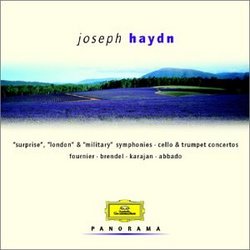| All Artists: Franz Joseph Haydn, Claudio Abbado, Herbert von Karajan, Rudolf Baumgartner, Berlin Philharmonic Orchestra, Chicago Symphony Orchestra, Lucerne Festival Strings, Alfred Brendel Title: Panorama: Joseph Haydn Members Wishing: 0 Total Copies: 0 Label: Deutsche Grammophon Release Date: 1/23/2001 Genre: Classical Styles: Forms & Genres, Concertos, Historical Periods, Modern, 20th, & 21st Century, Instruments, Brass, Strings, Symphonies Number of Discs: 2 SwapaCD Credits: 2 UPC: 028946914823 |
Search - Franz Joseph Haydn, Claudio Abbado, Herbert von Karajan :: Panorama: Joseph Haydn
 | Franz Joseph Haydn, Claudio Abbado, Herbert von Karajan Panorama: Joseph Haydn Genre: Classical
|
Larger Image |
CD Details |
CD ReviewsInterpretative noblesse! Hiram Gomez Pardo | Valencia, Venezuela | 05/26/2006 (4 out of 5 stars) "When Joseph Haydn composed concertos for diverse instruments, assumed a major involvement, dedication and charm with these works. And think probably the main fact was the Concertos genre (until Beethoven) was considered as a transition stage between the chamber music and the symphonic genre. We should not forget the dimensions of those Orchestras never surpassed the fifty members. The great Orchestras and Hall Concerts arrive after the French Revolution, when the Opera at last, gets out from its reduced spaces to be listened and delighted by non illustrated, analphabets who could assist outdoors to presence and hear in the stage the true representation of their intimate sorrows, disgraces and misfortunes.
In Mozart, for instance, there is not a big difference in which slenderness concerns between the Concertos for soloists and Symphonies. Evidently the musical scope of Mozart was by far, much major than J.H. The warmth and febrile rapture of the First Cello Concerto, is much more intimate than the Second, with a major dramatic character. In this sense Haydn proves that the drama sense could be suggested, but never remarked. The music was an evasion motive and not a reflect of the intimate universe of the human being. That aim would be the goal of the future composers. Pierre Fournier achieved one of his most celebrated performances with this set. There are many other versions, perhaps much sweetened and hyper romantic, but this version guarantees the accurate proportion between expression, tension and sentiment and not sentimentality. " |

 Track Listings (12) - Disc #1
Track Listings (12) - Disc #1